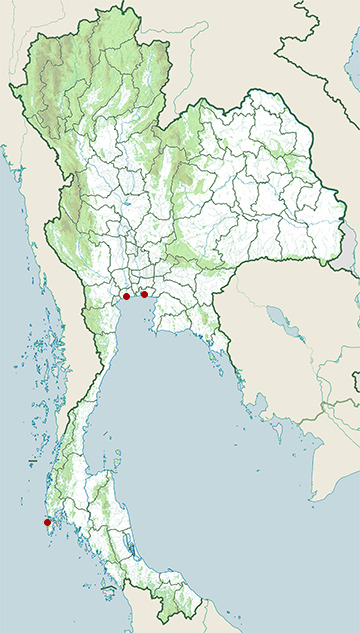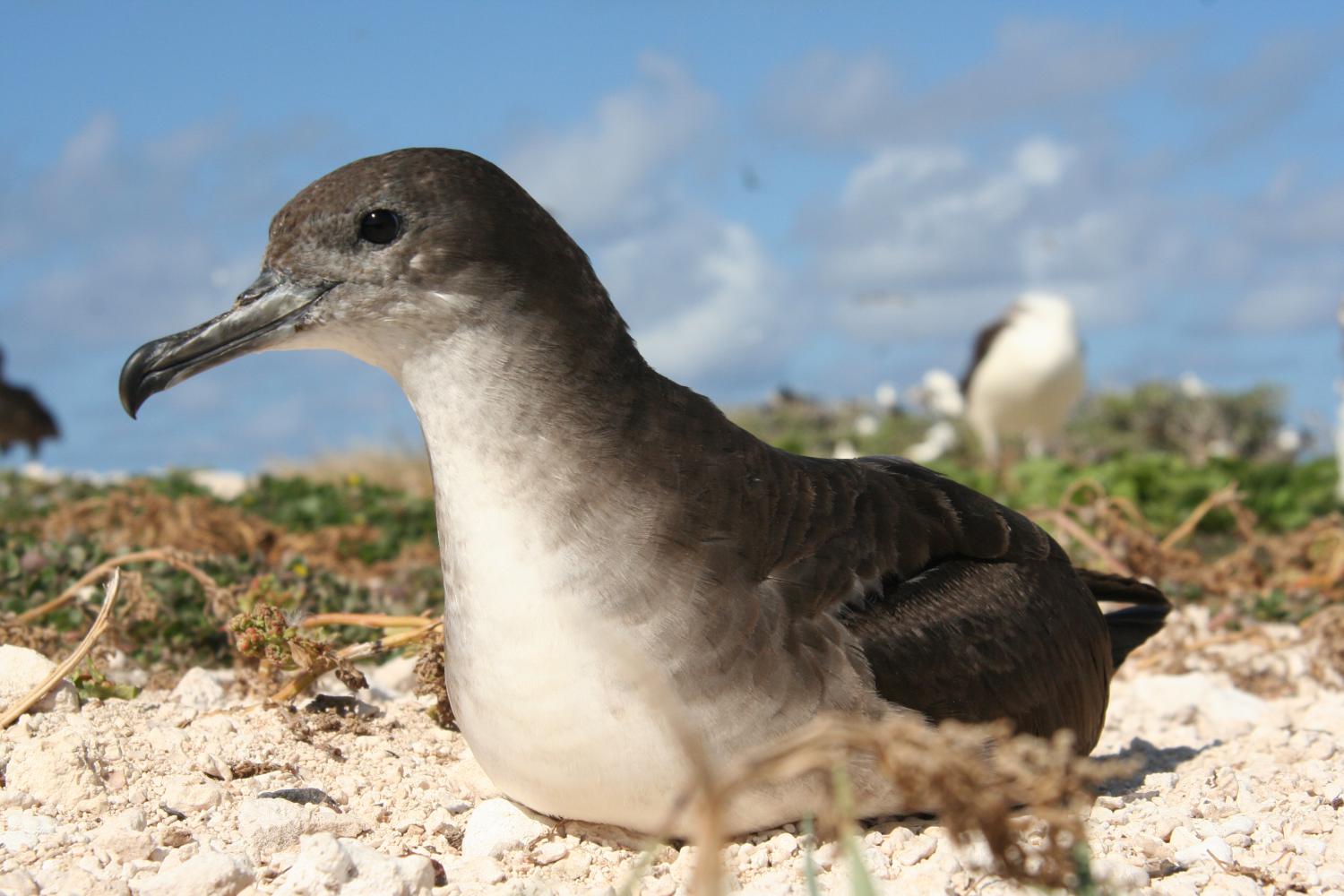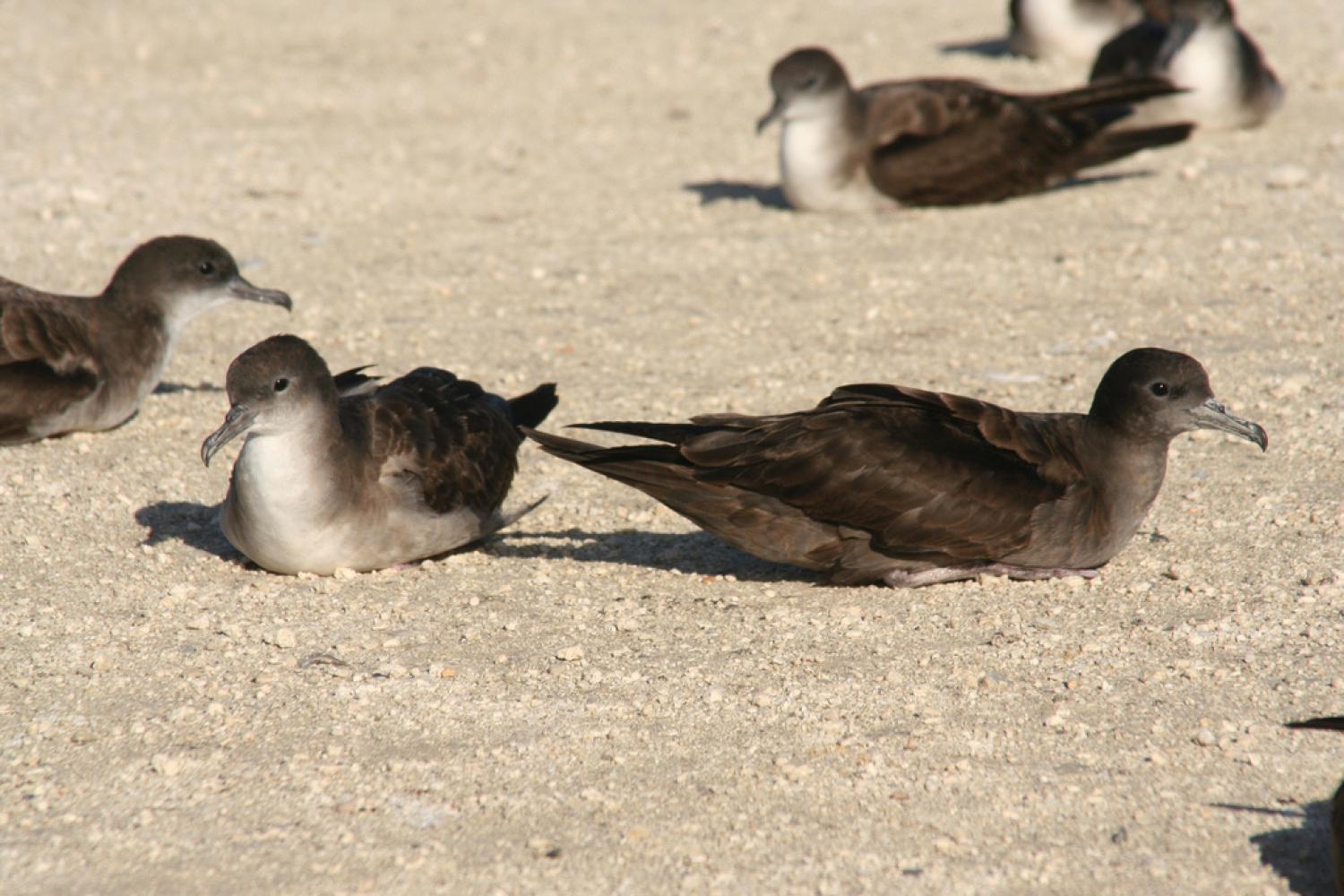Species of Thailand
Wedge-tailed shearwater
Ardenna pacifica
Johann Friedrich Gmelin, 1789
In Thai: นกจมูกหลอดหางพลั่ว
The wedge-tailed shearwater (Ardenna pacifica) is a medium-large shearwater in the seabird family Procellariidae. It is one of the shearwater species that is sometimes referred to as a muttonbird, like the sooty shearwater of New Zealand and the short-tailed shearwater of Australia. It ranges throughout the tropical Pacific and Indian Oceans, roughly between latitudes 35°N and 35°S. It breeds on islands off Japan, on the Islas Revillagigedo, the Hawaiian Islands, the Seychelles, the Northern Mariana Islands, and off Eastern and Western Australia.
Description
The wedge-tailed shearwater is the largest of the tropical shearwaters. The two colour morphs of the species are dark and pale; the pale morphs predominate in the North Pacific, the dark morph elsewhere. However, both morphs exist in all populations, and bear no relation to sex or breeding condition. The pale morph has grey-brown plumage on the back, head, and upper wing, and whiter plumage below. The darker morph has the same dark grey-brown plumage over the whole body. The species' common name is derived from the large, wedge-shaped tail, which may help the species glide. The bill is dark and legs are salmon pink, with the legs set far back on the body (in common with the other shearwaters) as an adaptation for swimming.
This species is related to the pan-Pacific Buller's shearwater, which differs much in colour pattern, but also has a wedge tail and a thin, black bill. They make up the Thyellodroma group, a superspecies of the large shearwaters that were for a long time included in the genus Puffinus.
Diet
Wedge-tailed shearwaters feed pelagically on fish, squid, and crustaceans. Their diet is 66% fish, of which the most commonly taken is goatfish. The species was thought to mostly take food from surface feeding, but observations of feeding wedge-tails suggested that contact-dipping, where birds flying close to the surface snatch prey from the water was the most commonly used hunting technique. However, a 2001 study which deployed maximum depth recorders found that 83% of wedge-tails dived during foraging trips with a mean maximum depth of 14 m and that they could achieve a depth of 66 m.
Breeding behaviour
The wedge-tailed shearwater breeds in colonies on small tropical islands. Breeding seasons vary depending on location, with synchronised breeding seasons more common at higher latitudes. Northern Hemisphere birds begin breeding around February, and Southern Hemisphere birds begin around September. Wedge-tailed shearwaters display natal philopatry, returning to their natal colony to begin breeding at the age of four.
Wedge-tailed shearwaters are monogamous, forming a pair bond that lasts for several years. Divorce between pairs occurs after breeding seasons that end in failure. Nesting occurs either in burrows or sometimes on the surface under cover. Pairs call frequently as a pair, both to reinforce the pair bond and warn intruders away from their territory. Parents also call to their chicks. The call is long, with an inhaling component (OOO) and exhaling component (err); their Hawaiian name 'ua'u kani means moaning petrel. Both sexes participate in digging a burrow, or repairing the burrow from last year. Nesting burrows of other species are also used. The breeding season of the Bonin petrel in Hawaii is timed to avoid that of the wedge-tail; in years where Bonin petrel chicks are still in burrows when wedge-tails return to begin breeding, these chicks are killed or evicted. It attends these colonies nocturnally, although nonbreeding wedge-tails are often seen at the surface throughout the day and breeding birds rest outside their burrows before laying.
Both sexes undertake a prelaying exodus to build up energy reserves; this usually lasts around 28 days. A single egg is laid, if that egg is lost, then the pair will not attempt another that season. After laying, the male usually undertakes the first incubation stint. Both sexes incubate the egg, in stints that can last up to 13 days. Incubation takes around 50 days. After hatching, the chick is brooded for up to 6 days, until it is able to thermoregulate, after which it is left alone in the nest while both parents hunt for food. It is initially fed with stomach oil, an energy-rich, waxy oil of digested prey created in the parent's gut; later, it is fed both solids and stomach oil. Like many procellariids, wedge-tailed shearwater parents alternate long and short trips to provide food, with the parents alternating between short foraging trips (1–4 days) and long trips (about 8 days), the two parents coordinating their feeding effort. Chicks increase in size to 560 g (larger than the adults), then drop to around 430 g before fledging. Fledging occurs after 103–115 days, after which the chick is independent of the adult.
Known breeding colonies include:
- Pacific Missile Range Facility, Kauai, Hawaii
- Heron Island, Australia
- Lady Elliot Island, Australia
- Lord Howe Island, Australia
- Montague Island, Southern New South Wales, Australia
- North West Island, Australia
- Muttonbird Island, Coffs Harbour, Northern New South Wales, Australia
- Mānana Island, Hawaii, United States
- Ilot Maitre, Noumea, New Caledonia
- Round Island, Mauritius
- Ka'ena Point, Oahu, Hawaii
- Mañagaha, Saipan, CNMI
- San Benedicto Island, Revillagigedo Islands, Mexico
- Alphonse Island, Republic of Seychelles
- Bijoutier Island, Republic of Seychelles
This article uses material from Wikipedia released under the Creative Commons Attribution-Share-Alike Licence 3.0. Eventual photos shown in this page may or may not be from Wikipedia, please see the license details for photos in photo by-lines.
Category / Seasonal Status
Wiki listed status (concerning Thai population): Accidental
BCST Category: Recorded in an apparently wild state within the last 50 years
BCST Seasonal status: Non-breeding visitor
Scientific classification
- Kingdom
- Animalia
- Phylum
- Chordata
- Class
- Aves
- Order
- Procellariiformes
- Family
- Procellariidae
- Genus
- Ardenna
- Species
- Ardenna pacifica
Common names
- English: Wedge-tailed Shearwater
- French: Puffin du Pacifique
- Thai: นกจมูกหลอดหางพลั่ว
Synonyms
- Ardenna pacifica, Les Christidis & Walter E. Boles (2008)
- Ardenna pacifica pacifica, Les Christidis & Walter E. Boles (2008)
- Thyellodroma cuneata, Gregory Macalister Mathews & Tom Iredale (1915)
- Puffinus pacificus hamiltoni, Gregory Macalister Mathews (1912)
- Puffinus cuneatus, Gregory Macalister Mathews (1888)
- Puffinus chlororhynchus, René-Primevère Lesson (1831)
- Puffinus pacifica, Johann Friedrich Gmelin (1789)
- Puffinus pacificus, Johann Friedrich Gmelin (1789)
- Procellaria pacifica, Johann Friedrich Gmelin (1789)
Conservation status

Least Concern (IUCN3.1)
Photos
Please help us review the bird photos if wrong ones are used. We can be reached via our contact us page.
Range Map

- Phuket Coast
- Samut Prakan Coast
- Samut Sakhon Coast

